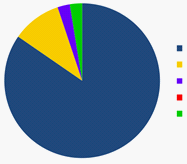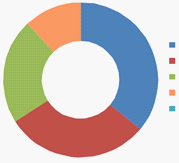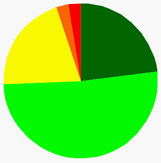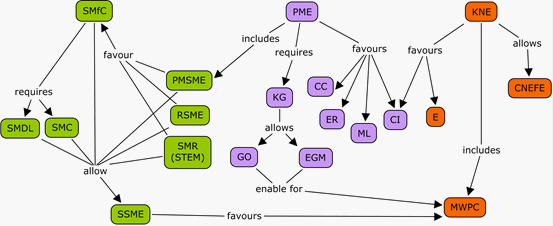Broadening teacher training: playful learning in non-formal contexts for science and mathematics education
Abstract
Currently, new ways of learning to develop skills such as creativity and scientific and mathematical thinking are needed. Teachers need to be prepared to face this challenge by engaging with education in any context, including non-formal ones. Moreover, in such a changing world, non-formal education could be a rich source of jobs. Work opportunities may arise if teachers in training begin to see themselves as entrepreneurial professionals. We might ask: Are future teachers prepared to educate future generations in today’s world? In this shifting scenario, would an approach for teacher training concerning non-formal contexts, based on playful learning and specially focused on science and mathematics education, be worthwhile? As part of the higher education of pre-service kindergarten teachers, we undertook such an approach with the aim of broadening their training at the university. We sought the perceptions of the teachers in training, after the development of our approach, regarding its usefulness for their future professional development, giving them the opportunity to express their own reflections in writing. We studied the participants’ reflections following the qualitative-interpretive technique of content analysis of the speech. The results of the qualitative analysis provided the emergence of 19 units of meaning (subcategories). The study of the interrelationships among these units revealed the existence of 3 interrelated joined cores (categories). Those cores are: science and mathematics education, playful learning, and non-formal education, and around them the discourse of the educators in training was articulated.
Keywords: Scientific educationmathematical educationplayful learningnon-formal educationtoy libraryteacher training
1. Problem statement
Currently, new ways of learning to develop skills such as creativity and scientific and mathematical
thinking are needed. Teachers must be prepared to face this challenge by engaging with education in
any context, including non-formal ones. Moreover, in such a changing world, non-formal education
could be a rich source of jobs. Work opportunities may arise if teachers in training begin to see
themselves as entrepreneurial professionals. Places such as toy libraries, farm-schools, educational
camps, cultural clubs, and museums offer educators new professional opportunities as alternatives to a
conventional teaching career.
Studies on learning, conducted in museums, conclude that an educational activity in a museum
stimulates the imagination, intuition, and creativity, fomenting a type of learning which is not limited
to the cognitive level but includes emotional and imaginative levels (Perez & Moliní, 2004).
Specifically, in terms of extracurricular activities, science museums have been recognized as non-
formal educational contexts where scientific literacy can be promoted (Calvo & Stengler, 2004; Pérez
& Moliní, 2004). Studies have concluded that participation in extracurricular activities helps reduce
anti-social behaviour in young people, who are positively reinforced by the participation of the social
network of the individual, family, friends (Mahoney, 2000). This is an example of non-formal
education being important in social inclusion and the democratization of knowledge. The same is true
of toy libraries (Jackson, Robey, Watjus & Chadwick, 1991; Caldeira & Oliver, 2007; de Angelo &
Vieira, 2010), which provide an answer to the lack of equal access to education by their beneficial
action when difficulties appear in any of three areas: economic, personal or socio-cultural (de Borja,
1994).
Toy libraries are specialized centres aimed at children in which you educate through play. Are divided
according to their ownership, which can be public or private, being independent or integrated into
entertainment centres, schools, businesses, shops ... in which a space for the development of a play
workshop is enabled: can be public ownership and management, or private in management and public in
ownership, have an agreement with the administration or private both in management and ownership. At
the same time, we find models of toy libraries specialized in certain sectors of age, adapted to children
with special needs, hospital toy libraries, giants, travelling... (Ruiz de Peralta, 2009, p.522)
Toy libraries were initially modelled after libraries, dedicated to loaning games, but later expanded
as facilitators of playing areas, after the recognition of this activity as a right of children(Ruiz de
Peralta, 2009). Besides having the right to play, children learn while playing, and, by playing the right
games, they can learn a great deal. Particularly, games should be used to attract children to science and
mathematics (Haist & Burla, 2010). Playful learning is among the new ways recommended to foster
the skills needed in today’s world, as Hirsh-Pasek and Golinkoff (2008) have stated:
Play is, thus, central for school readiness and school performance. It might also play an important role in
preparing children for the global world beyond the classroom. Business leaders suggest that in the
knowledge age, success will depend on children having a toolkit of skills that include
(teamwork, social competence),
written),
Cs” is nurtured in playful learning. (p.4)
Those skills include scientific and mathematical thinking, with play constituting a valuable resource
for STEM education, i.e. interdisciplinary science, technology, engineering, and mathematics education
(Bergen, 2009). The literature offers examples in which play and games have been successfully applied
to teaching and learning of science in all stages of education, including higher education (Cabra, 2004,
Franco-Mariscal, Oliva-Martinez and Almoraim, 2014; Giménez, Pagés and Martinez, 2011; Muñoz,
2010; Noy, 2011; Rodriguez, 2007; Uría, 2004).
Furthermore, the analysis, projection, design, and evaluation of playful resources and games are
valuable tools for teacher training in science and mathematics (Fernández-Oliveras & Oliveras, 2014a).
With this idea, devoted not only to formal but to non-formal educational contexts, a subject matter was
introduced in the last year of the Bachelor’s Degree in Early Childhood Education at the University of
Granada (Spain). We set up this course in the year 2013 and have been developing it for three
academic years.
The experience gained so far confirms that the teachers in training have a positive attitude towards
play and the development of mathematical and scientific thinking as ingredients in an educational
approach (Fernández-Oliveras & Oliveras, 2014b, 2015). However, most teachers still have a
traditional way of addressing their entry into the labour market on completing their higher education, in
the sense they tend to look for jobs as teachers hired in public or private schools. Therefore, in our way
of approaching the subject matter, we emphasize non-formal education with the aim of broadening
teachers’ training during their higher education at the university. In this work, we investigate the
perceptions of the teachers in training who were involved in our approach, enquiring into its usefulness
for their professional future in order to ascertain their opinions about facing science and mathematics
education in non-formal contexts, once they completed the course.
2.Research Questions and Purpose of the Study
2.1.Research Questions
We ask: Are future teachers prepared to educate the next generations in today’s world, in which new
ways of learning to develop skills such as creativity and scientific and mathematical thinking are
already needed?
In this changing world, would an approach to teacher training concerning non-formal contexts,
based on playful learning and specially focused on science and mathematics education, be worthwhile?
2.2.Purpose of the Study
We aim to broaden teacher training during their higher education at the university, concerning non-
formal contexts and paying special attention to science and mathematics education.
To know their perceptions after their training, we surveyed the participants regarding the usefulness
of our approach for their future professional development.
3.Methods
3.1.Approach for Educator Training
As commented above, we undertook an approach to educator training in non-formal contexts, based
on playful learning and specially focused on science and mathematics education. This approach was
introduced as part of the higher education of pre-service kindergarten teachers, and developed in an
optional course of the last year of the Bachelor’s Degree in Early Childhood Education at the
University of Granada. In this university subject, we presented diverse games and playful resources for
children in preschool and elementary school. Traditional games of different cultures and commercial
educational games on the market were analysed by work teams of teachers in training, using a
systematic procedure. In addition to general aspects, the procedure was specially focused on science
and mathematics teaching and learning.
During the development of the course, each work team projected, designed, manufactured, and
analysed a game or a playful resource, dedicated primarily to educating children in science and
mathematics. At the end of the course, the teachers in training presented their games or playful
resources to the rest of the groups, adopting a professional role as members of a game-designers’ team.
The presentation prepared by each team for showing and analysing their own games was subjected to
three modes of evaluation (self-assessment, peer assessment, and teacher assessment).
A key part in our approach was the inclusion of visits to real contexts where non-formal education is
offered. We call such visits “field trips”, after which the educators in training conducted their “field
work”. With this goal, participants had to prepare the field trip previously and, during the visit, they
had to perform the tasks necessary to prepare the field work. Therefore, performing the field work
involved working before, during, and after the corresponding field trip.
The visits were made on two different days and included two public centres: an interactive science
museum and a toy library, and a private centre managed by an entrepreneur. We choose these
educational centres for being initiatives based on playful learning that incorporate aspects especially
related to science and mathematics education.
3.2.Research Methods
With the aim of stirring the reflections of the teachers in training after the development of our
approach, in the academic year 2015-2016, we used an optional questionnaire that almost 70% of the
students of this year answered (N = 39). An online platform was used to design and distribute the
survey, which had two parts. Given the optional nature of the subject matter, the first part of the survey
served to show the participants’ reasons for choosing it and was composed for two semi-closed-ended
questions (list of items plus a separate textual answer at the end, which respondents could fill out if
they did not select one of the suggested items). The second part of the questionnaire concerned the
usefulness of the approach for the participants’ professional future. It was mixed, composed of a
closed-ended question (Likert type) and an open-ended query, giving the teachers in training the
opportunity to express their thoughts in their own written words.
The research was descriptive and based on a qualitative-interpretive paradigm. By means of the
interpretation of that expressed by the teachers in training, we tried to display how they assembled in
conceptual fields and networks the elements related to the usefulness of the approach, as the teachers
were intended to act as implicit mediators of their professional performance when working with
children.
The research was interpreted from a pragmatic and social-constructivist theoretical framework. A
solid background was provided by the sociology of knowledge, which remains the basis for the
methods of qualitative understanding of human societies, especially for the contribution to the
understanding of the nature of science (Berger and Luckmann, 1966). Moreover, we took a socio-
constructivist perspective of scientific and mathematical knowledge (Ernest, 1997).
We used the technique of content analysis of the speech (Babbie, 2012; Pérez, 1998) as a model for
the qualitative analysis of the query and we added a quantitative analysis of the results found.
4.Findings
4.1.Sample Characterization
As mentioned above, the first part of the survey was intended to characterize the sample, in the
sense of knowing the participants’ reasons for choosing the subject matter, and was composed around
two semi-closed-ended questions. Figure
did you choose this subject matter?”. Participants could select only one of the items on the list. If
respondents selected the option “Others”, they could fill in a textual answer.

It can be seen that most participants (85%) chose the subject matter due to the topics addressed.
Only one respondent marked the option “Others”, citing curricular reasons (validation of a subject). It
bears mentioning that no participant chose the subject matter due to the lecturers who conducted it,
which means that no opinion was influenced for this reason.
The participants who chose the subject matter because of the topics (85%) were asked which
specific topic prompted their choice. In this case, respondents could choose as many options as they
wished from the list, including the option “Others”, filling in a textual answer. Their answers are
displayed in Figure

As can be seen, the most frequent response option was “Play in the teaching-learning process”
(55%), followed by “Mathematics education in kindergarten” (46%), “Science education in
kindergarten” (33%) and, finally, “Non-Formal education” (18%). No respondent marked the option
“Others” in this case. Of the respondents, 12% chose two options and 9% chose three, while the rest
chose only one response option.
4.2.Participants’ Perceptions
As indicated in Section
approach for the participants’ professional future. It was mixed and composed of two questions. The
first one was a closed-ended question (Likert type) and its answers can be seen in Figure

The subject matter was found highly useful by a 23% of the participants, quite useful by 51% of
them, and moderately useful by 21%. Only one respondent considered the subject matter as barely
useful, and another one found it not useful at all. In general terms, we can affirm that the participants
perceived the teacher-training approach performed as rather useful for their professional future.
The last question we added to the second part of the questionnaire was open-ended in order to allow
the participants’ to express their reflections in their own words. The question was: “In which aspects do
you consider that the subject matter is useful for your professional future?”. The qualitative analysis of
participants’ reflections, shown by means of the answers to this query, revealed the emergence of 19
different units of meaning. The study of the interrelationships among these units revealed the existence
of 3 interrelated joined cores. We call the units of meaning “emerging subcategories”, and the joined
cores, “emerging categories” (Pérez, 1998). In Table
categories, are listed. Figure

We can see that the most frequent category was the one related to non-formal education (56%),
although it was the one that brings together the fewest number of subcategories, with only 4
(approximately half of subcategories of that the other categories have). This is because the
aforementioned category includes the two subcategories that arose most frequently in the discourse of
the participants: knowledge of non-formal education (31%), and management and working in a toy
library (21%). That result is particularly striking given that non-formal education appeared as the topic
that,
involved. The third most frequent subcategory was educational games manufacture (18%), grouped
into the category regarding playful learning.
It bears mentioning the emergence of some especially meaningful subcategories, even though they
had a very low frequency (3%). Those key categories are: relations between science and mathematics
(raising the STEM-education idea), self-confidence as science and mathematics educators (dealing with
teacher qualification), children’s creativity (paying attention to the skills which educators should foster
in the children) and entrepreneurship (stressing the self-employment issue).
5.Conclusions
As part of the higher education of pre-service kindergarten teachers, we undertook an approach for
educator training in non-formal contexts, based on playful learning and specially focused on science
and mathematics education.
In general terms, we can state that the participants perceived the approach as being quite useful for
their professional future.
We studied the reflections of the teachers in training after the development of our approach,
following the qualitative-interpretive technique of content analysis of the speech. The results of the
qualitative analysis provided the emergence of 19 units of meaning (subcategories). The study of the
interrelationships among these units revealed the existence of 3 joined cores (categories) interrelated.
Those cores are:
1-Science and mathematics education
2-Playful learning
3-Non-formal education
and around them the discourse of the educators in training was articulated.
Acknowledgements
The authors express their appreciation to the Secretariado de Innovación Docente (University of Granada) for financing Teaching Innovation Project l5-44.
References
- Babbie , E. (2012). The Practice of Social Research.
- Bergen , D. (2009). Play as the learning medium for future scientists, mathematicians, and engineers.. American Journal of play. Avaible in. , 1, 413-428, http://www.journalofplay.org/sites/www.journalofplay.org/files/pdfarticles/1-4-article-play-as-learning-medium.pdf
- PLand Luckmann, T. (2001). La construcción social de la Aires: Amorrortu. , realidad. Buenos
- Cabra, N. (2004). Entre la ciencia y la magia, o los juegos del aprendiz. Nómadas, 21, 241-248
- Caldeira, V. A.Oliver, F. C. (2007). A criança com deficiência e as relações interpessoais numa brinquedoteca comunitária. Revista brasileira de crescimento e desenvolvimento humano,.. Avaible in. , 17(2), 98-110, http://pepsic.bvsalud.org/pdf/rbcdh/v17n2/11.pdf
- Calvo, C. V.Stengler, E. (2004). Los museos interactivos como recurso didactico: El Museo de las Ciencias y.
- (), el Cosmos. Revista electrónica de enseñanza de las ciencias, 3(1), 32-47.
- de Angelo, T. S.Vieira, M. R. R. (2010). Brinquedoteca hospitalar: da teoria à prática.Revista Arquivos de Ciências da Saúde,.. Avaible in. , 17(2), 84-90, http://repositorio-racs.famerp.br/racs_ol/vol-17-2/IDO4_%20ABR_JUN_2010.pdf
- de Borja, M. (1994). Las ludotecas como instituciones educativas: enfoque sincrónico y diacrónico. Revista
- (), interuniversitaria de formación del profesorado, (19), 19-41.
- Ernest, P. (1997). The nature of Mathematics and Teaching. Philosophy of Mathematics Education Journal, 9
- (), Avaible in: http://www.academia.edu/3188583/THE_NATURE_OF_MATHEMATICS_AND TEACHING.
- Fernández-Oliveras, A.Oliveras, M. L. (2014a). Braga: Hands-on Science Network. Avaible in: http://www.hsci.info/Book_HSCI_2014_lowres. , A4(pdf), training. In
- Fernández-Oliveras, A.Oliveras, M. L. (2014b). 1016/j.sbspro.2014.09.334.. Avaible in: http://edure.org/EduReJournalVol2N1/ EduRe_V2_I1_P3.pdf. , 2(1), 37-48, 856-861. DOI
- Franco-Mariscal, A. J.Oliva-Martínez, J. M.y Almoraim, M. L. (2014). Students’ Perceptions about the Use of Educational Games as a Tool for Teaching the Periodic Table of Elements at the High School Level. Journal of Chemical Education, Avaible in: http://pubs.acs.org/doi/pdf/, 92(2), 278-285. DOI:10.1021/ed077p144
- Giménez, C.Pagés, C.Martínez, J. J. (2011). Diseño y desarrollo de un juego educativo para ordenador sobre enfermedades tropicales y salud internacional: una herramienta docente más de apoyo al profesor universitario. Revista Eureka sobre Enseñanza y Divulgación de las Ciencias,/10862.. Avaible in: http://rodin.uca.es/xmlui/bitstream/handle/10498/10862/9_Pardo_et_al_2011.pdf?sequence=6&isAllowed=y. , 8(2), 10498-, 221-228. DOI
- Haist , T.Burla, A. (2010). Learning by playing - how to create the perfect learning game for and with Education and Outreach, San Diego. Proceedings of SPIE, 77830E-1–77830E-10.. Avaible in: http://proceedings.spiedigitallibrary.org/proceeding.aspx?articleid=754141. , optics. Optics
- Hirsh-Pasek, K.Golinkoff, R. M. (2008). Why Play = Tremblay R. E., Barr R. G., Peters R. De V., Boivin M., (Eds.), Encyclopedia on Early Childhood Development . Montreal: Centre of Excellence for Early Childhood Development.. Availble in: https://www.researchgate.net/profile/Kathy_Hirsh-Pasek/publication/237108843_Why_Play__Learning/links/0c9605260113d2d675000000.pdf. , 1-7, Learning. In
- Jackson, S. C., Robey, L., Watjus, M., & Chadwick, E., (1991). Play for all children: The toy library solution.
- (), Childhood Education, 68(1), 27-31.
- Mahoney, J. L. (2000). School extracurricular activity participation as a moderator in the development of.
- (), antisocial patterns. Child development, 71(2), 502-516.
- Muñoz, J. M. (2010). Juegos y Q formulación. Revista Eureka sobre Enseñanza y Divulgación de las, educativos. F
- (), Ciencias, 7(2), 559-565. DOI:10498/8927. Avaible in: http://reuredc.uca.es/index.php/tavira/article/view/14/11
- Noy, J. M. (2011). La resolución de problemas lúdicos y el trabajo práctico de laboratorio como estrategia didáctica para el aprendizaje de las ciencias en el ciclo tres de educación básica. Revista Iberoamericana de Educación,.. Avaible in. , 55(3), 1-16, http://www.rieoei.org/deloslectores/3476Noy.pdf
- Pérez, G. (1998). Investigación Cualitativa Retos e La Muralla. , Interrogantes. Madrid
- Pérez, C. A.Molini, A. M. V. (2004). Consideraciones generales sobre la alfabetizacion cientifica en los museos de la ciencia como espacios educativos no formales. Revista electrónica de enseñanza de las ciencias, 3(3), 339-362
- Ruiz de Peralta, N. R. (2009). La educación no formal en el último cuarto del siglo XX: las ludotecas como espacios educativos generados fuera de la escuela y su influencia en la identidad de gé El largo camino hacia una educación inclusiva: la educación especial y social del siglo XIX a nuestros días: XV Coloquio de Historia de la Educación, Pamplona-Iruñea, 29, 30 de junio y 1 de julio de. Universidad Pública de Navarra, 2009(pp. 515-524), nero. In
- Rodríguez, F. P. (2007). Competencias comunicativas, aprendizaje y enseñanza de las Ciencias Naturales: un enfoque lúdico. Revista Electrónica de Enseñanza de las Ciencias,.. Avaible in. , 6(2), 275-298, http://www.saum.uvigo.es/reec/volumenes/volumen6/ART4_Vol6_N2.pdf
- Uría, M. (2004). Jugar con la ciencia. Infancia: educar de 0 a 6 años, (87), 22-27
Copyright information

This work is licensed under a Creative Commons Attribution-NonCommercial-NoDerivatives 4.0 International License.
About this article
Publication Date
14 May 2016
Article Doi
eBook ISBN
978-1-80296-007-5
Publisher
Future Academy
Volume
8
Print ISBN (optional)
-
Edition Number
1st Edition
Pages
1-252
Subjects
Psychology, social psychology, group psychology, collective psychology, teaching, teaching skills, teaching techniques
Cite this article as:
Fernández-Oliveras, A., & Oliveras, M. L. (2016). Broadening teacher training: playful learning in non-formal contexts for science and mathematics education. In Z. Bekirogullari, M. Y. Minas, & R. X. Thambusamy (Eds.), Cognitive - Social, and Behavioural Sciences - icCSBs 2016, May, vol 8. European Proceedings of Social and Behavioural Sciences (pp. 162-171). Future Academy. https://doi.org/10.15405/epsbs.2016.05.17

